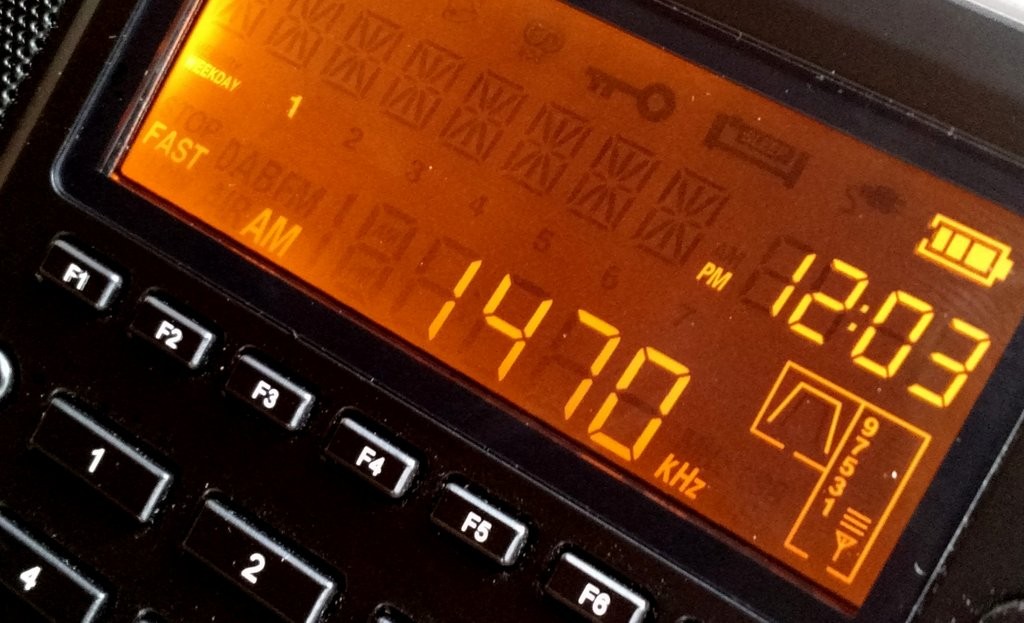(Source: Sky and Telescope via Sheldon Harvey)
When the Moon’s shadow glides across the U.S. on August 21st, you’ll have have a chance to hear the eclipse as it happens.
Solar eclipses are more than remarkable visual astronomical phenomena; they’re pretty interesting from a radio viewpoint too. Should overcast skies prevail over your location on eclipse day, you can still make some interesting observations using an AM radio.
Dramatic changes can take place in radio reception when day changes into night and vice versa. Perhaps you’ve had the experience of driving in your car at night, listening to some program on the AM dial, when the announcer will identify the station as WBBM in Chicago. This might seem odd if you are listening from Albany, New York, more than 700 miles (1,100 km) from the Windy City. Yet, cases like this happen every night.
A total solar eclipse produces a broad, round area of darkness and greatly reduced sunlight that travels across Earth’s surface in a relatively narrow path during the daytime. Its effect on sunlight’s local intensity is remarkably similar to what happens at sunrise and sunset. Distant radio stations along and near to the path of totality might briefly experience enhanced propagation, thus making long-distance reception possible during a solar eclipse unlike any other time.
I’ll be volunteering at the Pisgah Astronomical Research Institute (PARI) for the eclipse–they are in the path of totality. I also plan to do a spectrum recording of both the mediumwave and 31 meter band during the event.
Do any other SWLing Post readers have eclipse plans?


Interesting. Depends on the weather, want to stay away from thunderstorms for the noise. This looks doable for someone willing to travel. Maybe I’ll go??? Here are four sites that might be OK for setting up a portable antenna and small telescope. All are in the Central Time Zone:
outdoornebraska.gov/mormonisland/ (6$ day fee to use the park)
https://visitnebraska.com/stays/stanton-lake-park (free municipal park but has camping near)
https://mostateparks.com/park/st-joe-state-park (free to public during the day. Old lead mining site with offroad trails and flats and camping)
http://www.cityofwhitehouse.com/government/parks/facilities-and-parks/municipal-park (sprawling city park with large areas for sports)
Frequency (kHz) Call Sign Location Mid-Eclipse (UT) Mid-Eclipse (local) Central Time
1120 KPNW (B) Portland, OR 05:19:00 PM 10:19 a.m. PDT 12:19:00 PM
1190 KEX Portland, OR 05:19:00 PM 10:19 a.m. PDT 12:19:00 PM
670 KBOI (B) Boise, ID 05:27:00 PM 11:27 a.m. MDT 12:27:00 PM
1030 KTWO (B) Casper, WY 05:43:00 PM 11:43 a.m. MDT 12:43:00 PM
880 KRVN (B) Lexington, NE 05:57:00 PM 12:57 p.m. CDT 12:57:00 PM
1110 KFAB Omaha, NE 06:04:00 PM 1:04 p.m. CDT 01:04:00 PM
1040 WHO Des Moines, IA 06:08:00 PM 1:08 p.m. CDT 01:08:00 PM
1120 KMOX St. Louis, MO 06:18:00 PM 1:18 p.m. CDT 01:18:00 PM
840 WHAS Louisville, KY 06:27:00 PM 2:27 p.m. EDT 01:27:00 PM
650 WSM Nashville, TN 06:28:00 PM 1:28 p.m. CDT 01:28:00 PM
1510 WLAC Nashville, TN 06:28:00 PM 1:28 p.m. CDT 01:28:00 PM
750 WSB Atlanta, GA 06:36:00 PM 2:36 p.m. EDT 01:36:00 PM
1110 WBT Charlotte, NC 06:41:00 PM 2:41 p.m. EDT 01:41:00 PM
I live in northwest Louisiana and we listen to the following stations frequently and keep them programmed on our vehicle radios -1040 WHO, 650 WSM, 1510 WLAC, 750 WSB along with 1200 WOAI – our local AM station (710 KEEL) doesn’t cover much area at night.
They should have listed the stations by time of mid-eclipse instead of frequency. Seems like it is fast moving and the propagation over each station may only last 15 minutes or less, so, you would want to line up your listening to the path of the moon, not the order of the frequencies!
Already planned to grill out and have margaritas poolside on eclipse day with several friends – now we’ll have the AM radio on also.
Great to see the radio experiments being planned during the eclipse! I’ll be with the Exploratorium’s NASA-sponsored expedition team in the path where we’ll capture telescopic images of the sun and transmit high-dynamic range HD video live via satellite and internet from Oregon and Wyoming. Telescope views include filtering with calcium and h-Alpha. A sonification of the video, with Kronos Quartet, will offer a unique way to hear the eclipse. Anyone can watch live at exploratorium.edu/eclipse or via the free Total Solar Eclipse mobile/app which shows the path of totality and geolocates users to show what level of partial eclipse can be viewed directly from their location if not in the path.
I hope to be able to listen during the eclipse as well. Depending on the school schedule that day, I can show my students the effects of radio propagation. I will know more of my plans as that day nears. 73!